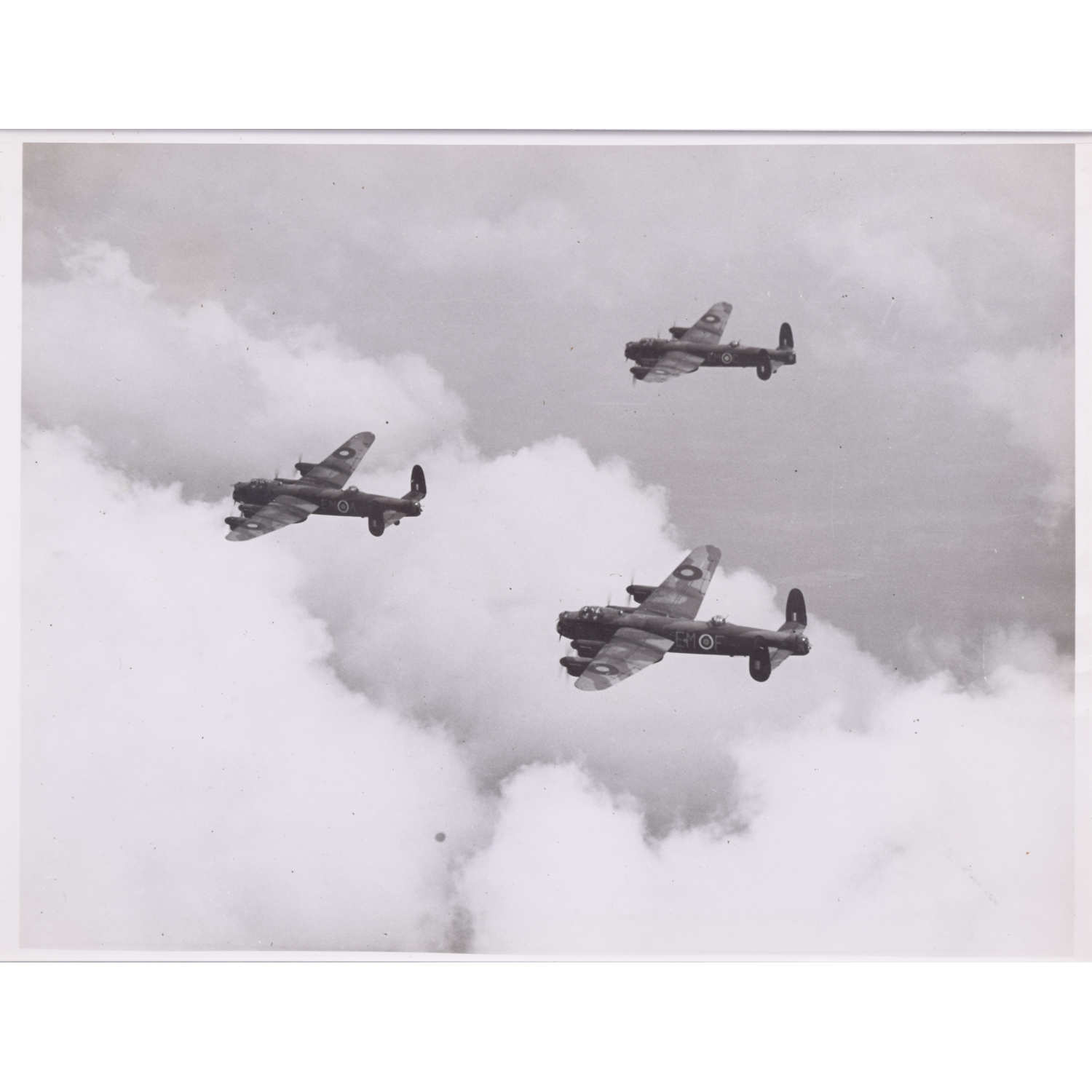Charles E Brown (1896-1982)
Three AVRO Lancaster Bombers in Flight
Original Silver Gelatin photograph, c. 1944
16 x 21 cm
Photograph 20 June 1942 above Cranwell
EM-A EM-C and EM-F of 207 Squadron
The RAF info website details the various Lancaster bombers of 207 Squadron.
EM-C was a Lancaster I with serial number R5695 . It took off on 25 November 1942 from Langar, on a mission to Haselunne. The pilot was an Alfred Parkyn of the RCAF – whose parents lived in New Jersey. The aircraft was lost without trace and the crew are commemorated on the Runneymede Memorial.
EM-A was another Lancaster I with serial number ED604. It took off from Langar on 12 March 1943 on a night mission (with 42% moon) to Essen, piloted by the 22-year-old F/O Michael Doble DFC. It crashed near Bottrop on the outskirts of Essen, with the loss of all its crew who are buried in the Reichswald Forest War Cemetery. Doble’s DFC was gazetted on 31 July 1942, following an action in which 12 DFCs and one DSO were awarded. The citation reads:
“The KING has- been graciously pleased to approve the following awards in recognition of gallantry displayed in flying operations against the enemy: —On 11th July, 1942, a force of bombers was detailed to make an attack on the submarine works at Danzig. The operation, which necessitated a high degree of skill and fortitude, was undertaken in extremely adverse weather. Despite this, the objective was reached by dusk, carefullyidentified and, in the face of strong oppositionfrom the ground defences, subjected to a most determined attack. Bombs were released at varying heights, some as low as 1,000 feet. Many hits were obtained. Searchlight posts were also machine-gunned and many searchlights extinguished. The success achieved reflects the greatest credit on the following personnel who participated in various capacities as leaders and members of aircraft crews.”
EM-F was a Lancaster I serial number R5694, piloted by Flight Lieutenant Raymund Joseph Hannan DFC which hit high ground in bad visibility at Easton, Lincs, home-bound from Bad Zwischenahn (Vechta) killing all the crew on 25 November 1942. Hannan was a New Zealander who had served for a year with the RNZAF prior to volunteering in September 1939 for the RAF. Following training he undertook a tour of 29 operations with 49 Squadron in the Handley Page Hampden, and after this served as an instructor in 25 Operational Training Unit. His DFC was gazetted on 24 October 1941. In September 1942 he was posted to 207 Squadron, flying four missions prior to that of 25 November 1942. This latter mission lasted only three hours – probably long enough to reach the Dutch coast and return to the UK, and certainly not long enough for the Luftwaffe aerodrome at Bad Zwischenahn. Upon return to base the aeroplane was unable to land owing to bad weather. It crashed near Goadby Marwood, the local history society of which have published an extensive history of the crew members at https://www.goadby-marwood-history.co.uk/the-crew-of-r5694-em-f . Five of the crew, including Hannan, are buried in St Mary’s Churchyard in Bottesford. The crash site was discovered in 2021, a full report here: https://www.goadby-marwood-history.co.uk/_files/ugd/bc525f_aedab371f8794f2eab2c0c9ea9721720.pdf The grave sites of the crew members are detailed here https://aviationtrails.wordpress.com/tag/r5694/
Charles E Brown was a famous photographer of aircraft whose father was a butcher in Wimbledon, London. Young Charles was given a camera for his 14th birthday and in 1911 photographed an Edwardian gentleman in trouble landing his balloon in neighbouring Southfields. This photograph was published in the Daily Mirror – the fee being half a crown – and Brown was encouraged to join the Daily Mirror’s photography department upon leaving school at 16.
Towards the end of the First World War he served with the Royal Air Force at their official London Photographic Centre. Following the war, he took to photographing trains, and captured a famous photograph of a Southern Railway locomotive that was used for the following ten years in railway posters. The income from this allowed him to pursue his passion of aviation photography in the 1920s and 1930s, from which commissions from the Air Ministry and Fleet Air Arm followed. During the war his work included commissions for Aeronautics magazine.
Provenance: from the collection of Philip J R Moyes, author of many books on the RAF, most notably The Pictorial History which ran to several volumes.
Condition: Generally very good.









